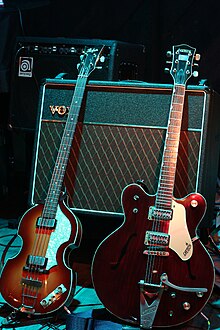Vox AC30


The Vox AC30 is probably the most famous guitar amplifier from the English company JMI (Jennings Musical Instruments), founded in 1957, later renamed Vox . This combo amplifier model is one of the most famous stage amplifiers . The model is produced in two versions: AC30 and the later introduced version AC30 Top Boost with extended tone control . The AC30 has an output of 30 watts, which it delivers to the two deep blue painted Celestion AlniCo Blue loudspeakers.
The amplifier's reputation was founded on several important rock and pop musicians and bands who have used it: the Shadows , the Beatles , Rory Gallagher , who already used the AC30 at Taste and thus influenced Brian May from Queen . " The Edge " from Irish rock band U2 also uses the AC30.
The AC30 was previously developed in 1959 by Tom Jennings from a year on the market appeared AC15, initially the one used in AC15 EF86 - Pentode in the preamp, the beginning of the 1960s by a ECC83 was replaced. When Hank Marvin from the Shadows combined two Vox AC15 amplifiers during the recording for the number 1 hit Wonderful Land and discovered a previously unknown depth and softness of the guitar sound and, on the other hand, the push-pull power amplifier equipped with two EL84 tubes With its 15-watt output power, which was not sufficient for sound reinforcement in larger halls, Vox developed the AC30 with twice the output power. For this purpose, four power pentodes were used in the push-pull output stage, with two EL84s connected in parallel.
The special sound properties of the VOX AC30 together with the considerable heat development of this output stage, which is increased to four output tubes , were mostly attributed to the supposed class A operation of the output stage, in which the position of the operating point is in the middle of the characteristic curve of the output tubes. However, more detailed investigations show that the circuit design of the output stage is a class AB amplifier , in which the operating point is actually shifted in the direction of higher quiescent currents than in comparable amplifiers from other manufacturers. More important for the sound result is the fact that the AC30 is a pure “straight-ahead amplifier”, i.e. does not use any power-consuming or corrective negative feedback , and the 12-inch Celestion Bulldog loudspeakers used at the time play with their high efficiency a crucial role.
Many other guitar amplifiers, from Fender to Marshall to Hiwatt , use the linearizing effect of a moderate negative feedback, in which the presence control is usually integrated.
The standard high quiescent current adjustment of the AC30 can be with a higher resistance of the built-up common cathode resistor reduce. As an alternative, some AC30s were supplied with a cathode resistance of 80 ohms, whereby the characteristic sound properties of the amplifier are essentially retained and the power tubes are spared.
Web links
- AC30 Guide (page with information, modding etc ... engl.)
- Background information on the AC30 (Engl.)
Individual evidence
- ↑ Bruce Welch: Rock 'n' Roll, I Gave You the Best Years of My Life: A Life in the “Shadows” , p. 86, ISBN 0-670-82705-3 (en), 1st edition 1989
- ↑ Randall Aiken: Is the Vox AC-30 Really Class A? Aiken Amplification, February 18, 2014, accessed May 22, 2019 .